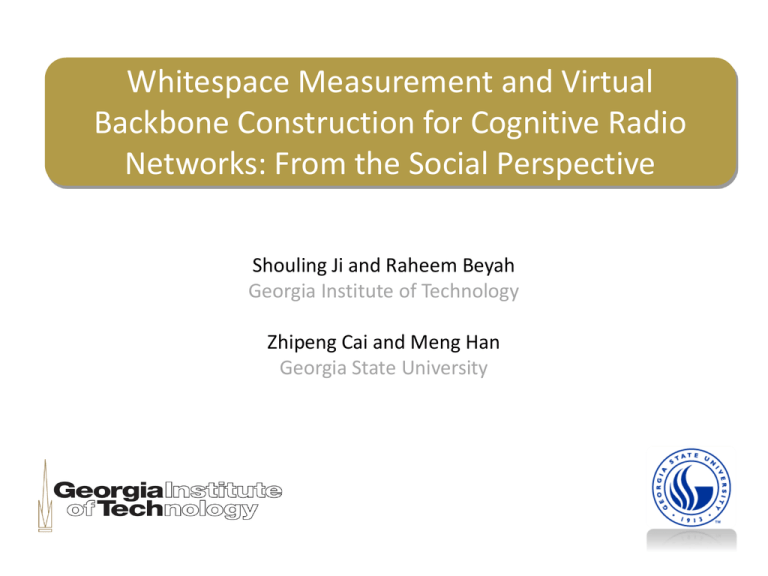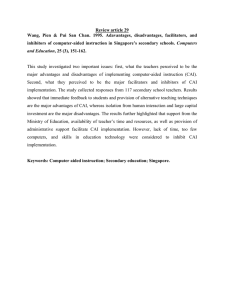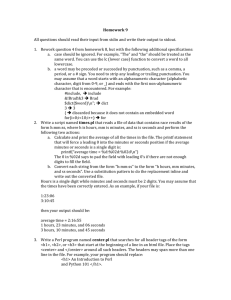Whitespace Measurement and Virtual Backbone Construction for Cognitive Radio
advertisement

Whitespace Measurement and Virtual Backbone Construction for Cognitive Radio Networks: From the Social Perspective Shouling Ji and Raheem Beyah Georgia Institute of Technology Zhipeng Cai and Meng Han Georgia State University Introduction Secondary Users (SUs) Primary Users (PUs) S. Ji, Z. Cai, M. Han, and R. Beyah Whitespace Measurement and VB Construction Introduction • Problem – Systematically analyze the spectrum whitespace in CRNs from a social network perspective • Contribution – Propose a novel metric named centrality score to measure the active weights of PUs by considering each PU’s topological importance and the global primary network running and traffic information – Analyzed the whitespace for SUs under three primary activity social patterns: i.i.d. distribution, Poisson distribution, and Gaussian distribution – Propose a Spectrum Altitudes based Virtual Backbone (SAVB) construction algorithm S. Ji, Z. Cai, M. Han, and R. Beyah Whitespace Measurement and VB Construction Outline • Introduction • System Model • PUs’ Social Attributes and Whitespace Analysis • Virtual Backbone (VB) construction • Simulation • Conclusion S. Ji, Z. Cai, M. Han, and R. Beyah Whitespace Measurement and VB Construction System Model • Primary Network – N Poisson distributed PUs with density of λp – Transmission and interference radii: R and RI – The network time is slotted with each time slot of length τ – The licensed spectrum bandwidth W – The primary network is dense scaling • Secondary Network – n randomly deployed SUs – Transmission and interference radii: r and rI – The secondary network is connected and dense scaling S. Ji, Z. Cai, M. Han, and R. Beyah Whitespace Measurement and VB Construction Outline • Introduction • System Model • PUs’ Social Attributes and Whitespace Analysis • Virtual Backbone (VB) construction • Simulation • Conclusion S. Ji, Z. Cai, M. Han, and R. Beyah Whitespace Measurement and VB Construction Centrality Score of PUs • Motivation: local and global activity behavior of PUs • Centrality score of a PU Si Expected # of active PUs The # of shortest paths in the primary network S. Ji, Z. Cai, M. Han, and R. Beyah The betweenness centrality of Si: the number of shortest paths passing Si The average # of PUs on shortest paths Whitespace Measurement and VB Construction Centrality Score of PUs • Centrality score of a PU Si The average # of active PUs on each shortest path The weight of a PU on each shortest path to be active The normalized weight of Si to be active S. Ji, Z. Cai, M. Han, and R. Beyah Whitespace Measurement and VB Construction Social Activity Pattern of PUs • By recent empirical studies – i.i.d. activity pattern – Poisson distribution pattern , e.g., the GSM90 uplink service – Gaussian distribution pattern mobile device holders, WiFi users S. Ji, Z. Cai, M. Han, and R. Beyah , e.g., cell phone users, cellular network users, Whitespace Measurement and VB Construction Whitespace Analysis • i.i.d. activity – The lower and upper bounds of the centrality score of PU Si – The lower and upper bounds of the active probability of PU Si – The lower and upper bounds of the available spectrum whitespace for a secondary link S. Ji, Z. Cai, M. Han, and R. Beyah Whitespace Measurement and VB Construction Whitespace Analysis • Poisson distributed pattern • Gaussian distributed pattern S. Ji, Z. Cai, M. Han, and R. Beyah Whitespace Measurement and VB Construction Outline • Introduction • System Model • PUs’ Social Attributes and Whitespace Analysis • Virtual Backbone (VB) construction • Simulation • Conclusion S. Ji, Z. Cai, M. Han, and R. Beyah Whitespace Measurement and VB Construction Virtual Backbone (VB) Construction • Definition of VB – A VB B of the secondary network is a subset of SUs such that (i) every SU is either in B or has some neighbor in B; and (ii) B is connected. • Objective – Seek a VB with small size – Seek a VB with more spectrum bandwidth available • Spectrum altitude – Measures the average available whitespace at SU su – A high implies su has more neighbors and high available spectrum whitespace to its neighbors on average S. Ji, Z. Cai, M. Han, and R. Beyah Whitespace Measurement and VB Construction Virtual Backbone (VB) Construction Seek a Maximal Independent Set (MIS) M of the secondary network Final a minimal set C of connectors to connect the independent nodes in M S. Ji, Z. Cai, M. Han, and R. Beyah Whitespace Measurement and VB Construction Virtual Backbone (VB) Construction • Correctness analysis of SAVB • Performance analysis of SAVB S. Ji, Z. Cai, M. Han, and R. Beyah Whitespace Measurement and VB Construction Outline • Introduction • System Model • PUs’ Social Attributes and Whitespace Analysis • Virtual Backbone (VB) construction • Simulation • Conclusion S. Ji, Z. Cai, M. Han, and R. Beyah Whitespace Measurement and VB Construction Simulation • Settings – Time is slotted with each time slot is normalized to one – The primary bandwidth is normalized to 100 – Examine the unicast throughput under different primary activity distributions • Comparison – US (Journal of Combinatorial Optimization, 2013): a VB is first constructed on top of a cell-based network partition; then, the unicast is carried out on the VB S. Ji, Z. Cai, M. Han, and R. Beyah Whitespace Measurement and VB Construction Simulation • Whitespace estimation • Successful delivery ratio S. Ji, Z. Cai, M. Han, and R. Beyah Whitespace Measurement and VB Construction Conclusion – We provide a mathematical framework for deriving the whitespace for SUs • With local and global primary activity consideration • With typical primary social patterns consideration – Propose a spectrum altitude based virtual backbone construction algorithm S. Ji, Z. Cai, M. Han, and R. Beyah Whitespace Measurement and VB Construction Thank you! Shouling Ji sji@gatech.edu http://users.ece.gatech.edu/sji/ S. Ji, Z. Cai, M. Han, and R. Beyah Whitespace Measurement and VB Construction




